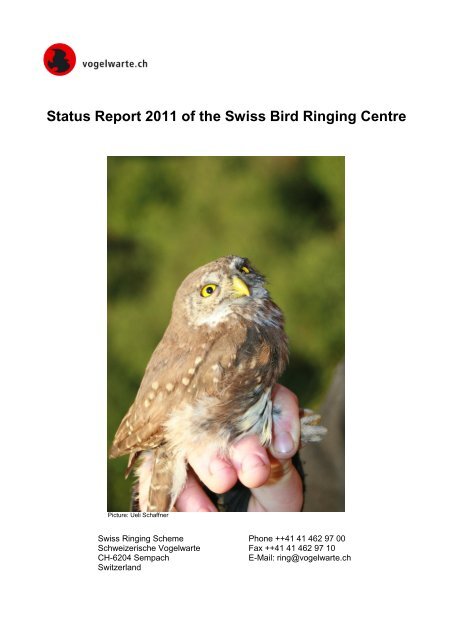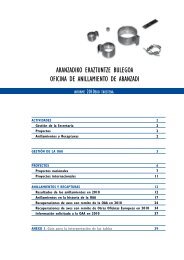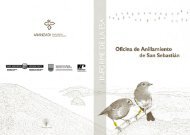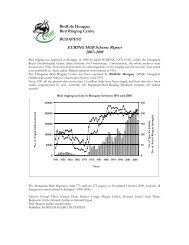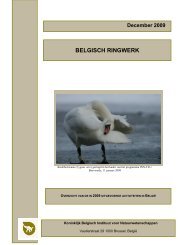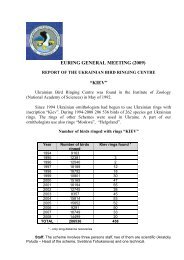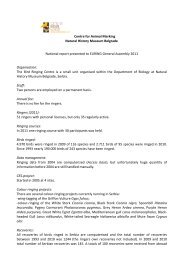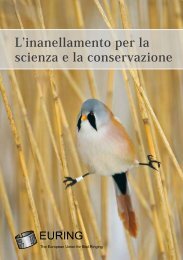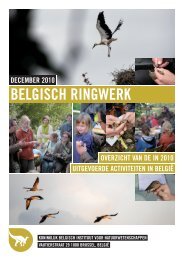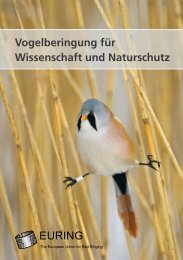Sempach, Switzerland - The European Union for Bird Ringing
Sempach, Switzerland - The European Union for Bird Ringing
Sempach, Switzerland - The European Union for Bird Ringing
- No tags were found...
You also want an ePaper? Increase the reach of your titles
YUMPU automatically turns print PDFs into web optimized ePapers that Google loves.
Status Report 2011 of the Swiss <strong>Bird</strong> <strong>Ringing</strong> CentrePicture: Ueli SchaffnerSwiss <strong>Ringing</strong> Scheme Phone ++41 41 462 97 00Schweizerische Vogelwarte Fax ++41 41 462 97 10CH-6204 <strong>Sempach</strong>E-Mail: ring@vogelwarte.ch<strong>Switzerland</strong>
Status Report 2009 of the Swiss <strong>Bird</strong> <strong>Ringing</strong> Centre 21. Organization and recent developmentsCatching and ringing of wild birds in <strong>Switzerland</strong> is under the “Federal Law on Hunting andon the Protection of Mammals and <strong>Bird</strong>s Living in the Wild”. <strong>The</strong> Swiss <strong>Ringing</strong> Scheme isput in charge <strong>for</strong> the coordination of bird ringing by the Swiss Agency <strong>for</strong> the Environment,Forests and Landscape SAEFL that also finances the running of the scheme. <strong>The</strong> contract<strong>for</strong> this invaluable support has been extended until 30 June 2012.<strong>The</strong> Swiss <strong>Ringing</strong> Scheme is based at the Schweizerische Vogelwarte <strong>Sempach</strong> (SwissOrnithological Institute; www.vogelwarte.ch). <strong>The</strong> Institute is a private foundation whosemandate is to contribute to the study and the protection of birds through excellence in avianmonitoring, research, conservation, services, teaching and training. <strong>The</strong> <strong>Ringing</strong> Schemereports to the Scientific Director, Dr Lukas Jenni.<strong>The</strong> <strong>Bird</strong> ringing scheme at the Swiss ornithological institute in <strong>Sempach</strong> issues bird ringswith inscription „<strong>Sempach</strong> Helvetia“ <strong>for</strong> use in <strong>Switzerland</strong> only.<strong>The</strong> <strong>Ringing</strong> Scheme has developed and introduced a new software package <strong>for</strong> registrationand online transfer of data from ringed and controlled birds. <strong>The</strong> new system has beeninstalled by the end of March 2008 and since then periodically improved, in collaborationwith the ringers’ community.2. Staff<strong>The</strong> main people involved in the work at the bird ringing scheme are:Jacques Laesser (65 % <strong>for</strong> the ringing scheme): Head of scheme, licenses, data bankmanager, rings, political and public issues. Email address:jacques.laesser@vogelwarte.ch.Sarah Althaus (55% <strong>for</strong> the ringing scheme): data bank manager, rings, equipment. E-mail address: sarah.althaus@vogelwarte.chGuido Häfliger (Engineer, 10 % <strong>for</strong> the ringing centre): data bank maintenance andsupport, software development. Email address: guido.haefliger@vogelwarte.ch.An advisory board of six highly experienced ringers is assisting the <strong>Sempach</strong> scheme on avoluntary basis.Matthias Kestenholz keeps serving as Vice-Chairman of EURING up to this year (electedin 2005).3. <strong>Bird</strong> ringers286 ringers (111 with a licence of category A <strong>for</strong> all species, 175 with a licence of categoryB (only one or a few species) or C (injured or orphaned birds) are dealing with a total of183 projects.5 candidates successfully passed the ringer's examination in 2009 and 3 in 2010.
Status Report 2009 of the Swiss <strong>Bird</strong> <strong>Ringing</strong> Centre 34. <strong>Ringing</strong> and recovery numbersIn 2009, 59’992 birds of 163 species were ringed in <strong>Switzerland</strong>. <strong>The</strong> most common specieswere Robin with 5’136 captures and Great Tit with 4’387. Among nestlings, Great Titwas number one with 3’334 chicks ringed. In total, 1’855 ringing recoveries entered thedata base.In 2010, 83’451 birds from 168 species were ringed in <strong>Switzerland</strong>. <strong>The</strong> most commonspecies were Great Tit with 8’827 captures and Chaffinch with 7’322. Among nestlings,Great Tit was number one with 4’975 chicks ringed. In total, 4’953 ringing recoveriesentered the data base.<strong>The</strong> full reports (Laesser et al. 2010, 2011) are available from the Swiss <strong>Bird</strong> <strong>Ringing</strong>Scheme.All Swiss ringing recovery data were transferred to the EURING data bank by March 2011.5. Projects<strong>The</strong> following projects are directed by the Swiss <strong>Bird</strong> <strong>Ringing</strong> Scheme:<strong>The</strong> Swiss <strong>Ringing</strong> Scheme is running the Alpine ringing station “Col de Bretolet” at 1923m a.s.l. on the Swiss-French border.<strong>The</strong> nation-wide Integrated Population Monitoring Programme <strong>for</strong> the Kestrel Falco tinnunculusand the Barn Owl Tyto alba continued. It aims at studying (1) how population changesare reflected by population parameters and (2) how they disperse.6. Publications6.1. Publications by the ringing schemeLaesser, J., G. Häfliger & J. von Hirschheydt (2009): Numbers of birds ringed and recovered by the<strong>Sempach</strong> <strong>Ringing</strong> Centre in 2008. Typoskript, Schweizerische Vogelwarte <strong>Sempach</strong>. 8 S.Laesser, J., G. Häfliger & J. von Hirschheydt (2010): Numbers of birds ringed and recovered by the<strong>Sempach</strong> <strong>Ringing</strong> Centre in 2009. Typoskript, Schweizerische Vogelwarte <strong>Sempach</strong>. 8 S.6.2. Publications reporting studies under licence of the ringing schemeAebischer, A., P. Nyffeler & R. Arlettaz (2009): Wide-range dispersal in juvenile Eagle Owls (Bubo bubo)across the <strong>European</strong> Alps calls <strong>for</strong> transnational conservation programmes. J. Ornithol. 151, 1-9.Almasi, B., Jenni, L., Jenni-Eiermann, S., Roulin, A. (2010): Regulation of stress response is heritable andfunctionally linked to melanin-based coloration. J. Evol. Biol. 23 (5), 987-996.Arlettaz, R., Schaad, M., Reichlin, T.S., Schaub, M. (2010): Impact of weather and climate variation onHoopoe reproductive ecology and population growth. J. Ornithol. DOI 10.1007/ s10336-010-0527-7.
Status Report 2009 of the Swiss <strong>Bird</strong> <strong>Ringing</strong> Centre 4Bächler, E., Hahn, S., Schaub, M. Arlettaz, R., Jenni, L., Fox, J.W., Afanasyev, V., Liechti, F. (2010): YearroundTracking of Small Trans-Saharan Migrants Using Light-Level Geoloca-tors. PLoS ONE 5 (3):e9566. Doi:10.1371/journal.pone.0009566.Baillie, S. & M. Schaub (2009) : Understanding changes in bird populations – the role of bird marking.<strong>Ringing</strong> & Migration 24, 189-198.Bairlein, F. & M. Schaub (2009): <strong>Ringing</strong> and the study of mechanisms of migration. <strong>Ringing</strong> & Migration 24,162-168.Bowlin, M. S., Henningsson, P., Muijres, F. T., Vleugels, R. H. E., Liechti, F., Hedenström, A. (2010): <strong>The</strong>effects of geolocator drag and weight on the flight ranges of small migrants. Methods in Ecology &Evolution doi: 10.1111/j.2041-210X.2010.00043.x.Coudrain, V. (2009): Food or nesting place? Identifying factors limiting wryneck populations. Masterarbeit,Institut für Ökologie und Evolution, Univ. Bern.Falsone, K., Jenni-Eiermann, S., Jenni, L. (2009): Corticosterone in migrating songbirds during enduranceflight. Hormones and Behaviour 56, 548-556.Grüebler, M. U., Naef-Daenzer, B. (2010): Brood overlap and male ornamentation in the double-broodedbarn swallow. Behavioral Ecology 21: 513-519.Grüebler, M. U., Naef-Daenzer, B. (2010): Survival benefits of post-fledging care: experi-mental approach toa critical part of avian reproductive strategies. Journal of Animal Ecolo-gy 79, 334-341.Hegelbach, J. (2009): Einfluss der Wassertemperatur auf das Überwintern der Wasseramsel Cinclus cinclusam Küsnachter Bach (Kanton Zürich). Ornithol. Beob. 106, 429-434.Helfenstein, F., Losdat, S., Möller, A. P., Blount, J. D., Richner, H. (2010): Sperm of colourful males arebetter protected against oxidative stress. Ecology letters 13, 213-222.Hofer, J., Korner-Nievergelt, F., Korner-Nievergelt, P., Kestenholz, M, Jenni, L. (2009): An indication of longtermgroup <strong>for</strong>mation in Tufted Duck Aythya fuligula. Ardea, 97 (3), 349-355.Keller, V. (2009): <strong>The</strong> Goosander Mergus merganser population breeding in the Alps and its connections tothe rest of Europe. Wildfowl Special Issue 2, 60-73.Korner-Nievergelt, F., Hofer, J., Sauter, A., Jenni, L. (2009): Measuring within-winter move-ment rates ofTufted Duck Aythya fuligula and Common Pochard Aythya ferina based on ring re-encounter data.Wildfowl Special Issue 2: 24-41.Martinez, N., Jenni, L., Wyss, E., Zbinden N. (2010): Habitat structure versus food abun-dance: theimportance of sparse vegetation <strong>for</strong> the common redstart Phoenicurus phoenicu-rus. J. Ornithol. 151:297-307.Mayer, C., Schiegg, K., Pasinelli, G. (2009): Patchy population structure in a short-distance migrant:evidence from genetic and demographic data. Molecular Ecology 18, 2353-2364.Mermod, M., Reichlin, T. S., Arlettaz, R., Schaub, M. (2009): <strong>The</strong> importance of ant-rich ha-bitats <strong>for</strong> thepersistence of the Wryneck Jynx torquilla on farmland. Ibis, 151, 731 742.Mermod, M., Reichlin, T. S., Arlettaz, R., Schaub, M. (2009): Vorläufige Ergebnisse einer Langzeitstudie zumWendehals in der Schweiz. Schriftenreihe aus dem Nationalpark Harz, Band 3, 78-81.Ott, M. (2009): Identifying potential predators of lapwing Vanellus vanellus chicks in the plain of Wauwil - Abait experiment with camera traps. Practical Training Report, University of Zurich, Faculty of Science,Institute of Environmental Sciences, 26 pp.Ravussin, P.-A., Arrigo, D., Roch, J. (2009): Un nouveau cas de trigynie chez le Gobemouche noir Ficedulahypoleuca. Nos Oiseaux, 56, 99-104.Reichlin, T. S., Schaub, M., Arlettaz, R., Jenni, L. (2009): Zugrichtungen europäischer Wendehälse.Schriftenreihe aus dem Nationalpark Harz, Band 3, 82-85.Reichlin, T. S., Hobson, K. A., Wassenaar, L. I., Schaub, M., Tolkmitt, D., Becker, D., Jenni, L., Arlettaz R.(2010): Migratory connectivity in a declining bird species: using feather isotopes to in<strong>for</strong>m demographicmodelling. Diversity and Distributions, 643-654.Roulin, A., Altwegg, R., Jensen, H., Steinsland, I., Schaub, M. (2010): Sex-dependent selection on anautosomal melanic female ornament promotes the evolution of sex ratio bias. Ecology Letters 13: 616-626.
Status Report 2009 of the Swiss <strong>Bird</strong> <strong>Ringing</strong> Centre 5Sauter, A., Korner-Nievergelt, F., Jenni, L. (2010): Evidence of climate change effects on within-wintermovements of <strong>European</strong> Mallards Anas platyrhynchos. Ibis 152, 600-609.Schaub, M., Aebischer, A., Gimenez, O., Berger, S, Arlettaz, A. (2010): Massive immigration balances highanthropogenic mortality in a stable eagle owl population: Lessons <strong>for</strong> conservation. BiologicalConservation 143, 1911-1918.Schifferli, L., Rickenbach, O., Koller, A., Grüebler, M. (2009): Massnahmen zur Förderung des KiebitzesVanellus vanellus im Wauwilermoos (Kanton Luzern): Nesterschutz vor Landwirtschaft und Prädation.Ornithologischer Beobachter 106: 311-326.Steiner, F. A., v. Hirschheydt, J. (2009): Nachtfang einer Türkentaube Streptopelia decaocto auf dem Col deBretolet (Kanton Wallis). Ornithol. Beob. 106, 439-441.Stier, K. S., Almasi, B., Gasparini, J., Piault, R., Roulin, A., Jenni, L. (2009): Effects of corti-costerone oninnate and humoral immune functions and oxidative stress in barn owl nestlings. J. of ExperimentalBiology 212, 2085-2091.Tolkmitt, D., Becker, D., Reichlin, T. S., Schaub, M. (2009): Variation der Gelegegrössen des WendehalsesJynx torquilla in Untersuchungsgebieten Deutschlands und der Schweiz. Schriftenreihe aus demNationalpark Harz, Band 3, 69-77.Zingg, S., Arlettaz, R., Schaub, M. (2010): Nestbox design influences territory occupancy and reproduction ina declining, secondary cavity-nesting bird. Ardea 98: 67-75.21 September 2011, Jacques Laesser


